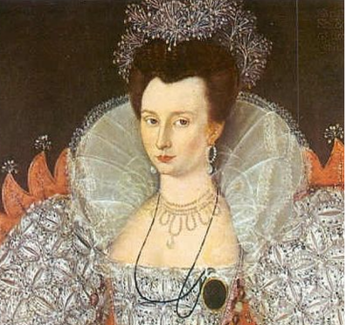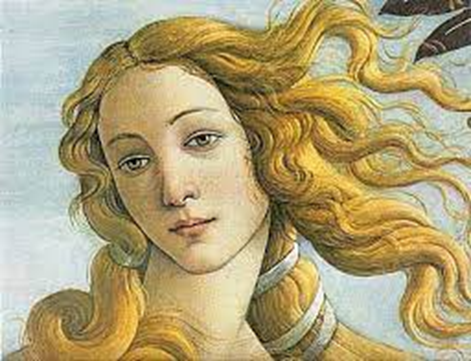|
Shakespeare's Sonnet #130
- My mistress' eyes are nothing like the sun;
- Coral is far more red than her lips' red;
- If snow be white, why then her breasts are dun;
- If hairs be wires, black wires grow on her head.
- I have seen roses damasked, red and white,
- But no such roses see I in her cheeks;
- And in some perfumes is there more delight
- Than in the breath that from my mistress reeks.
- I love to hear her speak, yet well I know
- That music hath a far more pleasing sound;
- I grant I never saw a goddess go;
- My mistress, when she walks, treads on the ground.
- And yet, by heaven, I think my love as rare
- As any she belied with false compare.
Sonnet #130 is the greatest of what have come to be known as
Shakespeare's "dark lady" sonnets. Because we know almost nothing about
the bard's personal life imaginations have run wild trying to identify the
dark-skinned woman whose eyes are "nothing like the sun."
G.B. Harrison proposed a brothel-keeper nicknamed "Black Luce," whom
Shakespeare may have met at the first performance of TwelfthNight. There
are two other London brothel keepers nicknamed "Black Luce," however,
which suggests that "black" refers in all three cases to the immorality of the
oldest profession, rather than to the color of the madams. This has not kept
many from assuming that the dark lady is of African descent, as does
Anthony Burgess in his novel Nothing Like the Sun; and William Boyd in
the BBC series A Waste of Shame in which Shakespeare contracts Syphilis
from his dark lady brothel keeper.
Another candidate, Emilia Bassano, is from a Mediterranean family,
cousins of whom are described as "black," although that could just be
another word for "brunette." Emilia does have going for her the fact that
she published a book of poetry and that "Emilia" is a character in Othello and Bassanio in The Merchant of Venice, indicating that Shakespeare may
have been playing with his lover's name.
Back in 1890, Shakespeare scholar Thomas Tyler claimed that Mary Fitton,
mistress of William Herbert, Earl of Pembroke, was Shakespeare's dark
lady. His theory was shot down a few years later when a portrait of Mary
Fitton surfaced with fair skin, brown hair and hazel eyes which didn't stop
Shaw from using her as the basis for his 1910 play The Lady of the Dark
Sonnets.
 |
None of this detective work has produced an actual woman whom William
Shakespeare clearly had an affair with, and it is highly unlikely that further
efforts ever shall. But let us imagine that a future scholar will one day
prove to everyone's satisfaction that Shakespeare's dark lady was not a
poetic fiction, but Lady X or Y, Shakespeare's real-life lover. Would that
fact augment future appreciation or understanding of the poem? Not at all,
since the biographical Shakespeare and dark lady sought in the real world
do not exist in the poem. It's success, in fact, partly depends upon the poet
keeping real or fictional biographical details about both the speaker and his
lady out of the poem.
What do we know about the speaker? That he is a man who is in love with
an exotic woman whose skin, eyes and hair are dark; that he finds her
beautiful; that he has read lots of love poetry by lovers who adore their
mistresses for being fair ladies; that he finds their hyperbolic praise
unconvincing; and that he much prefers his mistress to theirs. That's all we
know about him and all we need to know to accomplish the poem's
mission.
The speaker begins by rejecting the most important poetic simile in the
toolbox of idealistic poets, the assertion that the women they adore are like
the sun, essential to the very life of the lover. Here's Petrarch boasting
about his adored Laura:

And here's Lord Henry Howard, Earl of Surrey, outboasting Petrarch and
all other poets, with his praise of his unnamed mistress:
"My lady's beauty passeth more
The best of yours, I dare well sayn,
Than doth the sun the candle-light,
Or brightest day the darkest night."
The dark lady's lover goes on to list the most common idealized cliches
such poets share in common, in each case describing his mistress as the
antithesis. Their lips are red as coral; hers are far less red. Their breasts are
white; hers are dun. The fine, thin, "wires" of their locks are golden; hers
are black and literally wiry. Their white cheeks have a hint of rosiness; her
dark cheeks show no such blush. Their breaths smell like delightful
perfume; her breath "reeks." Their voices are musical; hers is non-operatic.
When their ladies leave a room, they feel that a goddess is ascending into
heaven. Here's how our speaker feels when his mistress departs:
I grant I never saw a goddess go;
My mistress, when she walks, treads on the ground.
Shakespeare's metrical art is a triumph here. Both lines have the ten
syllables required for iambic pentameter; but the first line is the shortest
and the second the longest in the poem. The goddesses of courtly poetry
lack substance. They disappear in a whoosh, with their line only taking four
seconds to read. Our dark lady is mortal, earth-bound, substantial. Her exit
line, with its weighty onomatopoetic diction ("she," "walks," "treads,"
"ground") takes twice as long to read silently, more if we read it out loud.
Hers is a strong fictional presence, one we cannot just imagine, but actually
believe in.
And yet, by heaven, I think my love as rare
As any she belied with false compare
.
Our poem closes with an oath rivaled for its vehemence only by the
concluding couplet of Shakespeare Sonnet #116: "If this be error and upon
me prov'd, / I never writ, nor no man ever lov'd."
Conventional sonneteers assume that their hyperbolic similes will convince
readers that the ladies they flatter are rare. But those who, like our
speaker, have read scores of sonnets, all using the same implausible tropes,
experience no woman at all, just the overkill of ineffective boastful cliches
foisted on readers. By presenting his lady as their antithesis, our lover
establishes her as a true rarity.
Sonnet 130 is a great love poem. But by refusing to encumber his love with
biographical details Shakespeare widens his scope beyond the speaker's
love for his lady to a love for reality itself. Seeing through the clichés of
courtly poetry is a metaphor for seeing through all attempts to provide
implausible descriptions of the real world readers of poetry hail from.
"Marooned in a Blizzard of Lies"
We are now living in a culture where, in singer/composer Dave Frishberg's
words, we are "marooned in a blizzard of lies," as politicians, talking heads,
and millions of Cliff Clavens assure us that their ideological mistresses are
not just like the sun, they are the sun. Sonnet 130 can help us emerge
unharmed from that blizzard by seeing through the glittering fool's gold of
"false compare."
|